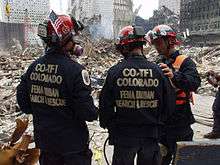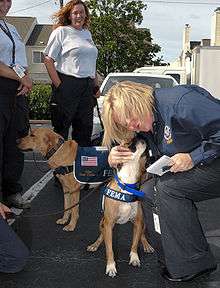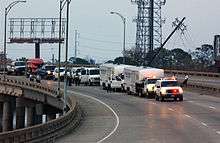FEMA Urban Search and Rescue Task Force

A FEMA Urban Search and Rescue Task Force (US&R Task Force) is a team of individuals specializing in urban search and rescue, disaster recovery, and emergency triage and medicine. The teams are deployed to emergency and disaster sites within six hours of notification. The Federal Emergency Management Agency (FEMA) created the Task Force concept to provide support for large scale disasters in the United States. FEMA provides financial, technical and training support for the Task Forces as well as creating and verifying the standards of Task Force personnel and equipment.
There are 28 Task Forces in the United States, each sponsored by a local agency. In the event of a disaster in the United States, the nearest three Task Forces will be activated and sent to the site of the disaster. If the situation is large enough, additional teams will be activated.[1]
Task Force makeup
Each Task Force is capable of deploying as a Type I with 70 personnel or a Type III with 28 personnel. This deployment configuration is increased if the Task Force mobilizes for a ground transport.[1]
Each task force member is a specialist in one of four areas:[1]
- Search - locating victims of a disaster
- Rescue - extricating a victim from the location where they are trapped, usually involving removing debris from around the victim
- Technical - structural specialists who provide engineering support for the rescuers
- Medical - providing medical treatment for the team, canines and victims before, during and after rescue
The search and rescue personnel are organized into four Rescue Squads, each composed of an Officer and five Rescue Specialists, and are capable of working 12-hour alternating shifts. The medical personnel include two task force physicians and four Medical Specialists.[2]
Canine rescuers

The canine rescuers are a critical element of each US&R Task Force as their keen sense of smell allows them to locate victims that might go undiscovered. The majority of the dog handlers on the Task Forces are civilian volunteers. The dogs are usually considered to be family pets by the handlers when the dogs are not on duty.[3]
The canine rescuers will become unmotivated if they are unsuccessful in locating victims, as they consider search and rescue to be a type of game. To keep the canines engaged after long hours of working, one of the Task Force members will hide in the rubble so the dog will have a successful 'find'. In most instances, the dogs do not wear any equipment (collars, vests, booties, etc.) while working a debris pile. Protective booties may be used in areas where traction is not a primary safety concern. However, on large, unstable debris piles dogs typically do not wear booties or other protective equipment as they need to be able to splay their paws to obtain maximum traction and maintain balance. Harnesses, collars and other equipment can also pose a serious risk to the dog while working if they were to become snagged on steel rebar or other items contained within a disaster site. Because the dogs often work out of sight and out of reach of the handler, it is critical to minimize the possibility of the dog becoming trapped in a confined space or choking from an entangled collar.[3] Because of the distinct possibility of injury from broken glass and metal, the medical unit maintains supplies for the canine rescuers.[2]
After first passing an evaluation of basic obedience, alert, directional control, agility and search skills currently known as an FSA (Foundational Skills Assessment), all canine/handler teams must pass an advanced certification known as a Certification Evaluation (or CE). This advanced certification process evaluates the ability of the canine and handler to locate an unknown number of buried subjects in multiple rubble piles in a limited period of time. All canine teams in the FEMA USAR system must achieve and maintain an advanced certification through the Certification Evaluation program to be considered a depolyable resource. This process is analogous to the Type II Basic and Type I Advanced certifications used prior to 2006.[4]
History
The origins of the FEMA Task Forces goes back to the early 1980s when the Fairfax County Fire and Rescue Department and Metro-Dade County Fire Department created search and rescue teams to deal with rescue operations in collapsed buildings. The State Department and the Office of Foreign Disaster Aid requested the help of these teams to assist with rescue operations in the 1985 Mexico City, the 1990 Luzon and the 1989 Leninakan earthquakes.
Seeing the value in having a network of such teams in the United States, FEMA created the National Urban Search and Rescue (US&R) Response System in 1989. In 1992, the concept was incorporated into the Federal Response Plan first published in 1992 and was later retained in the National Response Plan and the National Response Framework. FEMA sponsored 25 national urban search-and-rescue task forces. The number of teams has expanded to 28 since 1991.[1]
Notable US&R Task Force responses
Task Forces respond to a variety of different situations ranging from natural disasters such as hurricanes and earthquakes to man-made disasters such as gas explosions and bombings. Listed below are a few of the notable situations that US&R Task Forces have responded to:[1]
- Hurricane Iniki, Kauai, Hawaii - September 11, 1992
- Northridge earthquake, Los Angeles County, California - January 17, 1994
- Oklahoma City bombing, Oklahoma City, Oklahoma - April 19, 1995
- Hurricane Opal, Fort Walton Beach, Florida - October 6, 1995
- Humberto Vidal Explosion, Río Piedras, Puerto Rico - November 21, 1996
- Explosion of DeBruce grain elevator, Wichita, Kansas - 8 June 1998
- Izmit, Turkey earthquake - August 17, 1999
- Athens, Greece earthquake - September 7, 1999
- Hurricane Floyd - North Carolina - September 16, 1999
- Düzce, Turkey earthquake - 12 November 1999
- World Trade Center and Pentagon attacks, New York, New York and Washington, D.C. - September 11, 2001
- 2002 Winter Olympics, Salt Lake City, Utah - February 8–24, 2002 (Task Forces acted in a supporting role)
- Hurricane Katrina - 2005 [5]
- Hurricane Ernesto - 2006
- Greensburg, Kansas tornado - 2007
- Hurricane Ike & Gustav - 2008
- 2010 Port-au-Prince, Haiti earthquake [6]
- 2011 Christchurch, New Zealand earthquake (CA-TF2)
- 2011 Tōhoku, Japan earthquake and tsunami (CA-TF2, VA-TF1)
Task Force locations
The 28 teams of the US&R Task Force program are spread throughout the United States.[7] The teams are identified by the official two-letter U.S. Postal Service state abbreviations followed by the letters TF for Task Force and a sequential number for the number of the task force for that state. For example, the newest task force in the state of California, the San Diego Task Force, is identified as CA-TF8, being the 8th task force to be created in California.
- AZ-TF1 - Phoenix, Arizona - Phoenix Fire Department
- CA-TF1 - Los Angeles, California - Los Angeles City Fire Department
- CA-TF2 - Los Angeles County, California - Los Angeles County Fire Department
- CA-TF3 - Menlo Park, California - Menlo Park Fire Department
- CA-TF4 - Oakland, California - Oakland Fire Department
- CA-TF5 - Orange County, California - Orange County Fire Authority
- CA-TF6 - Riverside, California - Riverside Fire Department
- CA-TF7 - Sacramento, California - Sacramento Fire Department
- CA-TF8 - San Diego, California - San Diego Fire Department
- CO-TF1 - State of Colorado
- FL-TF1 - Miami-Dade County, Florida - Miami-Dade Fire Rescue Department
- FL-TF2 - Miami, Florida - Miami Fire Department
- IN-TF1 - Marion County, Indiana
- MD-TF1 - Montgomery County, Maryland - Montgomery County Fire & Rescue Service
- MA-TF1 - Beverly, Massachusetts
- MO-TF1 - Boone County, Missouri - Boone County Fire Protection District
- NE-TF1 - Lincoln, Nebraska - Lincoln Fire & Rescue Department
- NJ-TF1 - Lakehurst, New Jersey
- NV-TF1 - Clark County, Nevada - Clark County Fire Department
- NY-TF1 - New York City, New York - Fire Department of New York, New York City Police Department
- OH-TF1 - Miami Valley, Ohio
- PA-TF1 - Commonwealth of Pennsylvania
- TN-TF1 - Memphis, Tennessee - Memphis Fire Services
- TX-TF1 - College Station, Texas - Texas Engineering Extension Service
- UT-TF1 - Salt Lake City, Utah - Unified Fire Authority
- VA-TF1 - Fairfax County, Virginia - Fairfax County Fire and Rescue Department
- VA-TF2 - Virginia Beach, Virginia - Virginia Beach Fire Department
- WA-TF1 - Puget Sound region, Washington
The U.S. Army's 911th Engineer Company, modeled on a FEMA USAR Task Force, provides additional response to the National Capital Region.
Task Force equipment

FEMA has created a standardized list of equipment that each Task Force maintains. The 16,400 pieces of equipment are cached and palletized for quick access and transportation. The complete load of equipment weighs 60,000 pounds (27,215 kg) and is designed to be transported by tractor trailer or in the cargo hold of one C-141 transport aircraft or two C-130 transport aircraft.[8]
The equipment cache allows the Task Force to operate independently for up to four days. The cache contains five categories of equipment: Medical, Search and Rescue, Communications, Technical Support and Logistics.
Medical
The medical portion of the cache includes medical treatment and tools to provide sophisticated medical treatment for victims and task force members, including limited treatment of disaster search canines.[9] The treatment materials are designed to be enough to handle 10 critical cases, 15 moderate cases and 25 minor cases.[2]
Items included in the medical cache are medicines, intravenous fluids, blankets, suture sets, airways, tracheal tubes, defibrillators, burn treatment supplies, bone saws and scalpels.[8] On site, the "durable" medical equipment will stay with the Task Force when patients are transferred to other medical facilities. The local medical facilities must provide their own medical equipment as the equipment may be needed again by the Task Force.[2]
Search and Rescue
The Search and Rescue portion of the cache contains all the equipment that the Search and Rescue teams will need to extricate victims from debris. Technical search tools include telescopic cameras with heat detecting sensors and seismic listening devices (Delsar).
Construction type equipment such as concrete saws, jackhammers, drills and rope,[8] and technical rescue type equipment such as lifting airbags, shore systems, and hydraulic rescue tools.[9] Non-reusable shoring material such as lumber and pipe is not included in the cache and is to be found or acquired at the disaster site.
Communications
Generators, lights, radios, cellular phones, laptop computers[8] Task Force personnel will be issued portable radios at the point of departure to a disaster and are responsible for that radio until the Task Force returns to the point of departure. The radios operate in the 403-430 MHz range and are capable of penetrating structures and below grade environments (i.e. underground).[2]
Technical support
Snake-like cameras, fiberscopes, sensitive listening devices,[8] measuring devices such as laser rangefinders, strain gauges and levels; audio-visual equipment such as still and video cameras, LCD projectors; haz-mat equipment and support equipment for canines such as kennels, harnesses and sleeping pads.[9]
Logistics
Sleeping bags, cots, food and water, as well as cold weather gear,[8] portable toilets, portable showers, safety equipment such as gloves, earplugs, kneepads, respirators and protective eyewear; administrative equipment such as office supplies and reference materials; equipment maintenance materials and Task Force member's personal gear.[9]
See also
- Emergency management
- Paramedics in the United States
- Search and rescue in the United States
- National Association for Search and Rescue
- Mountain rescue in the United States
References
- 1 2 3 4 5 "About US&R". FEMA. Retrieved August 25, 2006.
- 1 2 3 4 5 "2003-2004 Task Force Equipment Cache List introduction" (PDF). FEMA. Retrieved August 28, 2006.
- 1 2 "Canine's Role in Urban Search and Rescue". FEMA. Retrieved August 28, 2006.
- ↑ "Canine Search Specialist Certification Process". FEMA. Retrieved September 24, 2013.
- ↑ Dorothy Moye, "Katrina + 5: An X-Code Exhibition," Southern Spaces 26 August 2010
- ↑ http://www.usaid.gov/press/releases/2010/pr100112.html USAID Responds Immediately to Haiti Earthquake PRESS RELEASE January 12, 2010
- ↑ "US&R Task Force Locations". FEMA. Retrieved August 25, 2006.
- 1 2 3 4 5 6 "US&R Task Force Equipment". FEMA. Retrieved August 25, 2006.
- 1 2 3 4 "FEMA Urban Search and Rescue Task Force 2003 - 2004 Equipment Cache List" (PDF). FEMA. 2003. Retrieved August 28, 2006.
External links
- "Urban Search and Rescue (US&R)". FEMA. Retrieved August 28, 2006.